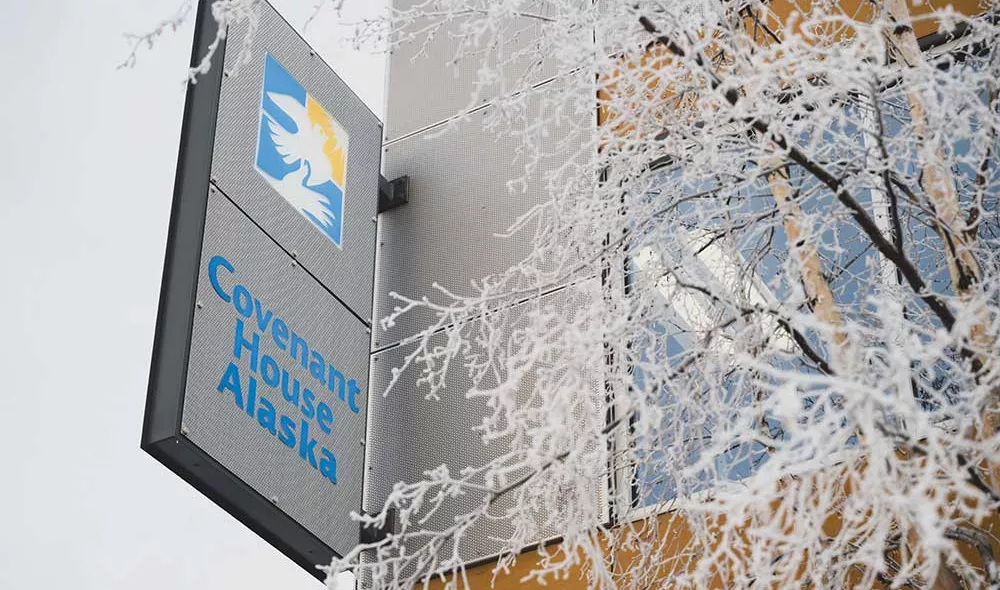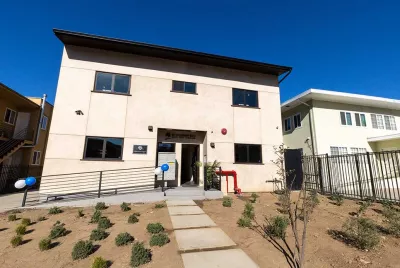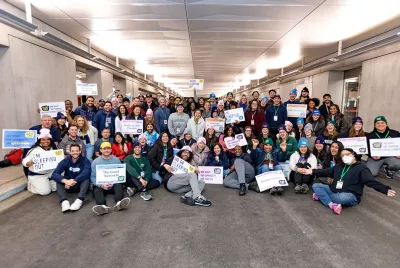A Bitter Winter in Anchorage

With record snowfall blanketing Anchorage, Covenant House Alaska is doubling down to respond to the spiraling needs of young people searching for our safe shelter during a relentless winter that is outpacing our every effort.
Every winter, CHA adds 25 overnight beds to an emergency overflow space for the duration of the cold weather season, a season that in Anchorage runs from September through May. Despite being temporary, these beds come with all our wraparound services, beginning with basic needs for food and clean clothes, mental and physical health care, and then, when youth feel secure and stable, education and career guidance.
This winter, though, young people experiencing homelessness in the city are finding their situation compounded not only by the record cold and snowfall but, also, by rising inflation, a rampant opioid crisis, an already burgeoning homeless population, and all the collateral effects these factors imply, such as curtailed access to critical services.
“When we started prepping for winter,” says Senior Director of Programs Randi Breager, “our stats went through the roof. We were turning away young people on a nightly basis because we were not only full within our emergency shelter but, also, in our emergency cold-weather overflow in the gym. We’re literally giving them coats, emergency blankets, tents, hand warmers, and sleeping bags and hoping they’ll make it through the night.”
Because winter is typically long and brutal in Anchorage, CHA begins preparing early for a seasonal increase of youth seeking shelter and services. But over the past year, the number of youth seeking shelter has gone up. “The rate of homelessness in Anchorage has increased dramatically across the full age spectrum,” Randi says, which makes referrals to sister organizations challenging. “People are flooding into Anchorage from many other communities.”
Those who have come to the city from Alaskan villages or the Lower 48 searching for gainful employment increasingly find themselves unable to afford the ever-rising cost of living. “One or two years ago, you could still get a one-bedroom apartment for $1,000 a month. Today, one-bedrooms are going for about $1,500 a month,” Randi says.
Youth begin to feel winter’s burden and the isolation it imposes with snow closures, blocked roads, and impeded access to public transportation, which impacts their job search, which impacts their living situation, and which compromises their physical health and emotional wellbeing. Youth who were inches away from homelessness, suddenly find themselves out in the cold and alone during the long, dark winter.

“Then it’s not about hunkering down for a few weeks or a month or two like it is in many states,” Randi says. “Our winter, with sub-zero temperatures, where people can’t safely sleep outside, can’t stay in tents, begins in September. And then it starts dipping and getting really, really cold, where they can get hypothermia, all the way through May.” It is not uncommon, she adds, to treat youth who come to CHA for debilitating frostbite.
This season’s record-setting cold and snow defy the usual strategies a youth might employ to deal with being unhoused. “When people think of homelessness, they think of all the ways one can survive, such as tent camping or living in their cars. In our winters, you can’t safely sleep in your car or you’ll freeze to death or accidentally poison yourself,” Randi says.
“We had a young person — and it terrified me — who parked their vehicle outside of Covenant House and ran an extension cord to our outlet outside, so they could run a little heater inside their car. Those heaters give off fumes, and the risk of fire is also incredibly high. One of the hardest things we had to do was take away their heat source and get them to come inside and engage with our services. We were afraid they would blow themselves up trying to keep warm.”
Another typical survival method is exchanging sex for a warm place to stay. “There’s an assumption out there that survival sex is a choice a young person makes and that they’re in control of that, when, really, they were stripped of choices long ago,” Randi says.
“We have these young people, children, who’ve been exposed to significant, severe, and repeated forms of trauma throughout their lives. Some get pulled into our child protective systems, but some don’t. And throughout this entire time, they’re having to learn coping strategies and survival skills that they take into young adulthood,” she explains.
Another coping skill involves using drugs, and in Alaska, as in many parts of the United States, the use of the synthetic opioid fentanyl has exploded. Unscrupulous drug dealers see a ready population of potential users in youth who are facing or vulnerable to homelessness. “They start giving it out for free,” Randi says. “Then they slowly raise the price.” When youth are hooked and using 10 to 15 pills a day, it becomes impossible to afford.
“That has compounded our concerns about survival sex,” Randi says. “Not only is survival sex a tool our young people use just to find a warm place to sleep for the night; now they’re also having to use it to fuel and feed an addiction that was systematically and purposely pushed on them in their vulnerability. It may be tempting to judge that young person, but she’s the very same person who at 8 told you she wanted to be a veterinarian, for instance. She is someone’s child.”
Daunting as these challenges seem, they haven’t kept Covenant House Alaska from actively seeking out, welcoming without question, and serving all the young people they can, especially during the long trial that is winter in Anchorage — and this winter in particular.
“Even before most young people end up on our doorstep to access our emergency shelter, we have a team of people that is going through all the known places they can think of within the city — camps and such — to talk to the young people and make sure they’re aware of our services,” Randi says.
Then, whether a youth secures a room in our shelter or a cot in our emergency overflow, the unconditional love and absolute respect become manifest in meals, a hot shower, clean clothes, and deep listening to their needs.
The harshness of this winter is outpacing our capacity to make room for every young person who needs our services, but we won’t stop working to ensure their safety.
Photos by Matt Waliszek
You might also like...
Shelter Is Only the Beginning
From crisis to care: Find out what it's like when a young person enters our doors.


